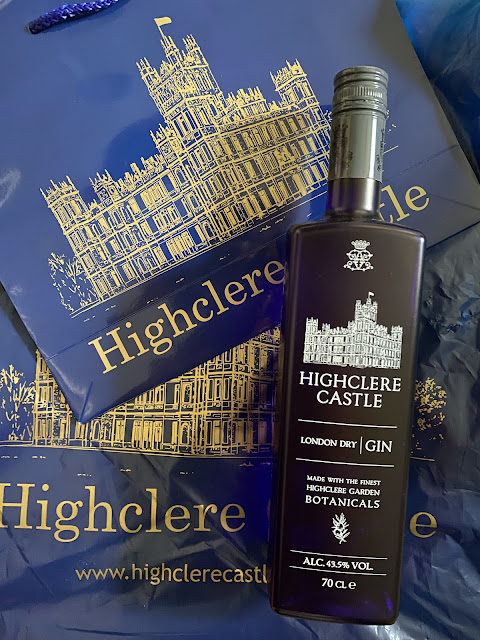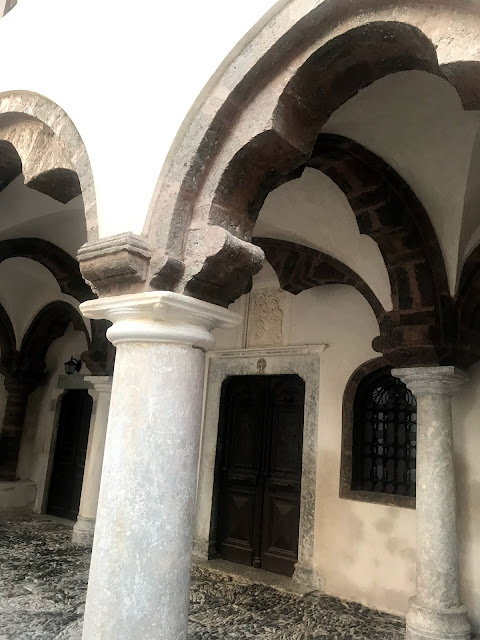What could be more quintessentially British than a bright warm sunny day and a trip to a magnificent country house?And if that country house is Downton Abbey, how perfect would that be?
Of course Downton Abbey is the fictitious Yorkshire home of Lord and Lady Grantham, though in actual fact, filming is at the country home of the 8th Earl and Countess of Carnarvon at the magnificent Highclere Castle, more than 200 miles away in Berkshire.
Anne C here....My Christmas present from my daughter was a two-day minibreak with National Holidays (more of that later), including a trip to Highclere Castle.
This was a perfect gift for such a Downton fan as myself, and it did not disappoint. We joined the tour on a glorious day in early May, and our first view of the house was breath-taking, and so familiar we almost felt as if we knew the house.
We were allowed in in small groups and were met by friendly volunteers who explained that we were free to follow the previous group but at our leisure. The only rules were that there was to be no photography inside and no food or drink, since this is still very much a private home with precious antique furniture, paintings and artefacts.
We wandered through the famous drawing room with its red velvet sofas, so very familiar on the show for pre-dinner drinks and family get-togethers. The famous dining room with its dark ancestral paintings was quite austere, and being honest, a little spooky!
OUR TOUR
Our guides told us that although the food on the set was real - brought in from the catering trucks parked outside - they did not eat it, since every angle had to be shot several times, so it wouldn't work if the plates were almost empty and then full again! In fact the only drink allowed on set was water, though the props man had special permission to have coloured water to use as red or white wine when the family took their drinks. Having said that, the late Dame Maggie Smith, who played the Dowager Countess, was allowed to have a cup of tea in the ladies' sitting room. This would have been the room where the ladies met early in the day, while they still wore their dressing gowns and before putting on their make-up for the day.
Another little snippet from the guides on the day - since the house is almost 400 years old, there's a lot of maintenance to contend with, and when it rains, the roof leaks - so there are buckets and pans placed strategically throughout the house.
In the series, the gentlemen retired to the smoking room after dinner, this was never actually filmed and the room was used to store furniture not needed.
Upstairs we were treated to a peek in the Countess's bedroom, on to Lady Mary's room where Turkish diplomat Kemal Panuck had a heart attack and died, Lady Edith's room, and Lady Sybil's, where she too died, of undiagnosed eclampsia after giving birth.
Then it was down the famous staircase which was often featured in the series and into the grand hall - much smaller than you would imagine - which was used for large events. It is actually a quadrangle with all the upstairs rooms overlooking the hall, which was very dark, having no external windows. It would only have had candlelight when first built, making it rather depressing, I think.
There was no access to the castle kitchens, since the scenes were actually filmed in the studios. So No Mrs Patmore and Daisy baking for the family! Highclere kitchens are in fact very modern since nowadays they cater for the afternoon teas, private events and weddings.
EATING AND DRINKING
While there was no Carson there to serve tea (we did have a delicious iced coffee and passionfruit cake in the tea room), both Anne and I were fortunate enough to meet actor Jim Carter some years ago at a charity afternoon tea.
Tea with Mr Carson - otherwise known as actor Jim Carter
Filming takes places from February until July, and although all the female actresses wore very glamorous 1920s outfits, in reality, they were dressed in puffer coats and Ugg boots while waiting for their scenes, with wardrobe on hand to touch up make-up and re-style hair.
EGYPTIAN EXHIBITION
As our tour of the house finished, we were directed into the basement, which obviously would have housed the kitchens when the house was originally build in 1679. Now it is also the home of an Egyptian Exhibition. It came as a surprise to me that the George Edward Stanhope Molineux Herbert, 5th Earl of Carnarvon funded the 1922 expedition led by George Carter, which found and excavated the tomb of Tutenkhamun. Most of the Earl's substantial fortune came to him in the form of the dowry from his marriage to American socialite Amira Wombwell, a member of the Rothschild family. Some of the original artifacts from his previous Egypt digs are on display at Highclere, but the orginal Tutenkhamun tomb and sarcophogus remain in his tomb in the Valley of the Kings. However, it seems the Earl fell foul of the curse of Tutenkhamun and died in Egypt following a mosquito bite in1923, aged just 56. I read that the family dog back home gave out a howl and died at the same moment the Earl took his last breath.... maybe something to do with the curse of Tutenkhamum.
The 5th Earl also founded the Highclere stud in 1902, and the family was one of the founders of Newmarket Races. The 6th Earl, Henry George Marius Victor Francis Herbert continued to develop the stud and breed champion horses. The 7th Earl, Henry George Reginald Molyneux Herbert - known as "Porchie," was the racing manager and friend to the late Queen Elizabeth 11 who was godmother to the current Earl.
The magnificent grounds surrounding the castle were the work of Capability Brown, who designed the gardens in 1771, though it seems the plans were actually carried out by estate staff. Lancelot "Capability" Brown created around 170 parks at some of the finest country houses and estates in the country, many of which survive to this day.
Today there is a tearoom and gift shop in the grounds, and on beautiful summer days, a marquee selling cocktails - and of course, Highclere gin. All that was missing was a game of croquet on the lawn!
NATIONAL COACH HOLIDAYS
Our holiday was booked through National Holidays, and in all honesty, I probably would not travel with them again. Day one was pick up day, and we spent almost five hours on the coach picking up from seven northern towns. It was the hottest day of the year and the air conditioning wasn't working for the first few hours, which caused complaints from many of the passengers. Our itinerary included a stop at a "place of interest" which wasn't specified. It turned out to be Oxford, but it would have been helpful to know this in advance - it wasn't a mystery tour. Had we known the destination, we could have planned something to do there. As it was, we wanted to find the river and enjoy some fresh air, but everyone we spoke to was a visitor there and didn't know the where the river was!
My daughter is gluten intolerant and had told the tour company in advance, since we were staying overnight in a hotel. While I'm not sure if the message hadn't been passed to the hotel (I won't name them), her gluten free meal was absolutely appalling - a burnt chicken skewer and GF bread roll.
It is also worth mentioning that there are restrictions at Highclere. There is a dress code which asks for smart casual attire and no backpacks are allowed. And pushchairs, wheelchairs or motorised walking aids are not permitted in the house. While this didn't affect us, it would have been useful for other members of our tour to have been warned in advance.
I have read several reviews on Highclere, and they do vary. Ticket prices, access and availability seem to be the main reasons for complaint. However, since we were on an organised tour, we didn't have any problems.
Was it worth it? As a day trip I would say it was a treat for Downton fans. And we are in for another treat, since the third feature film is due to launch later this year. Can't wait!
*These are my personal views - we have not received payment or free gifts for any of our blogs.









.jpg)













.jpg)








.jpg)




.jpg)
.jpg)
.jpg)
.jpg)



.jpg)



.jpg)
.jpg)
.jpg)

.jpg)

.jpg)
.jpg)

.jpg)
.jpg)




.jpg)